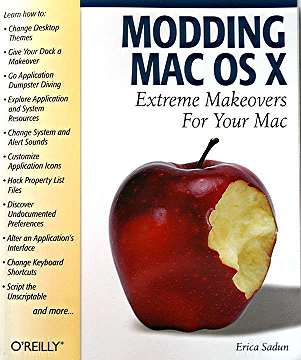
|

|
eXtensions
|
Choosing Macs and Making them Swing: Book Reviews |
Since OSX arrived, we have seen numerous books, ranging from the helpful (the "Missing Manual" series) to the technical, with some a little dry.
There are countless websites with a variety of approaches to solutions, or advice. Of note is Rob Griffiths' Mac OSX Hints. Rob has collected some 650 of the best hints and rewritten them for this book.
At 538 pages, it is highly useful, but needs someone unafraid of occasional command-line work to get the best out of some hints: many are easily accessible to those who will never stray from the Aqua interface. Flip throught this book at random and stop at any page: a hint will give an immediate improvement to the way one works.
The title may be slightly misleading: you do not need to be a "Power Hound", but you could be with a few of the hints. For example, when downloading in Safari, the display shows how much already downloaded, the file size and the time remaining. By using Option-click on that information, the speed (KB per sec) is shown.
Despite containing hints for improved practices, this is a book of great depth. The hints are delivered in sections (such as Dock, Applications, System Preferences). This book is staying in my home office and not going to work.

|

|
A different approach is taken by Erica Sadun in her "Modding Mac OSX". In some ways it reminds me of Scott Fullam's "Hardware Hacking Projects for Geeks" that I reviewed last year (5 May 2004). There is a strong yet gentle movement here. We get under the hood and make OSX work as an extension to the personality: colours, icons, images, for example; and the ways that the applications operate and display.
Sadun asks the reader to go along with her in a graded examination of the interface, the Unix and the preference files (plist files can be edited). Each section has icons which suggest the time, difficulty and "geekiness" of the adaptations to be explained. There is also a slightly pretentious "Chinese Take-Out Equivalent" (such as "Shredded chicken with garlic sauce", which has only two peppers alongside).
The value of this book, is not in the fixing -- these are strengths of Griffiths and Rizzo (below) -- but how the ideas here are better suited to projects and long term adjustments to individual computer environments. Each of these OSX books represents a different investment value. Each has its own usefulness.
There are things that annoy users of Macs: not many of us would admit this in public (see below). John Rizzo has taken a more personal approach with a question and answer format -- "The Annoyance" and "The Fix".
As well as this regular format, there are numerous boxes throughout with extra suggestions and useful ideas. Several solutions have URLs or sources listed. The work is well-illustrated (photos, screen shots and drawings), with clear text and many rather good ideas; overall it is a little short at just over 150 pages.
Of real value when we get so many atttachments with our e-mail these days: Mail can indicate this with a simple icon -- View> Columns> Attachments -- click and drag the column to the left to make it more visible.
The book has seven sections dealing with the annoyances that may be found in OSX, e-mail, the Internet, Microsoft Office, iLife, iPod and Hardware. There is also a good index that allows one to get to the written solution quickly.

|

|
I must admit to being wary of those who treat Apple almost like a religion, but every time a non-Mac user mentions the same myths about what is wrong with Macs, I do find myself defending my choice.
Leander Kahney picks up on this devotion (I did put Apple stickers on my last motorcycle) and has produced a high-quality book with the theme of Mac as life-choice.
One reviewer wrote one-line on "The Cult of Mac": he wished he had thought of it first. The book takes the view that Mac people are partisan, and demonstrates this with the way that (worldwide) users customize themselves and anything else that takes their fancy.
It is a best-seller in the US with its glossy paper and generous illustrations: most in colour. Kahney does not rely wholly on the images, but complements the photographs with his own interpretations.
A coffee-table book in a normal home, buyers should find a prominent site between the Macintosh and the iPod.

For further information, e-mail to Graham K. Rogers.
Back to
eXtensions
To
eXtensions: Book Reviews
To
eXtensions: Year One
To
eXtensions: Year Two
Back to homepage